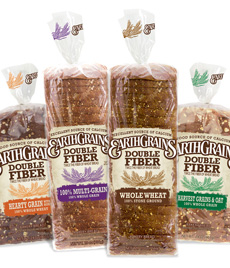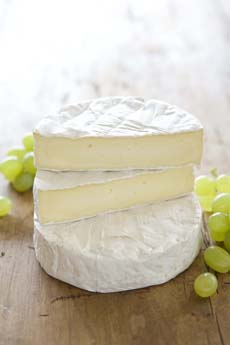| Boo, Sara Lee!
According to corporate and governmental watchdog, The Cornucopia Institute, a nonprofit farm policy research group, Sara Lee is trying to pull one over on consumers.
The popular supermarket brand has launched a marketing campaign for its EarthGrains bread, using misleading environmental-friendly catchphrases with the hope of attracting people who want to buy organics because they’re better for the environment and healthier to eat.
Sara Lee claims that “Eco-Grain™”—its trademarked ingredient that comprises just 20% of the grain in EarthGrains breads—is more sustainable than organic grain. This is not true, and the Cornucopia Institute has created a comparison chart to detail the differences. |
|

Sara Lee’s EarthGrains line. Not particularly
earth-friendly. Photo courtesy Sara Lee. |
According to Charlotte Vallaeys, a Food and Farm Policy Analyst at The Cornucopia Institute, “Sara Lee is doing practically nothing to ensure its ingredients are truly ecologically produced. It’s a crass example of a corporation trying to capitalize on the valuable market cachet of organic, while intentionally misleading consumers—without making any meaningful commitment to protect the environment or produce safer and more nutritious food.”
- The farmers who grow Eco-Grain differ very little from most conventional grain producers who use petroleum-based fertilizers, pesticides and fungicides.
- Organic farmers, on the other hand, use natural fertilizers, compost and crop rotations to enrich the long-term health of the soil, without damaging the environment or potentially contaminating the food produced.
- Sara Lee’s eco-claim for Eco-Grain production is that their farmers incorporate technology that has reduced chemical fertilizer usage by 15%. That means they’re using 85% chemical fertilizers.
- In contrast, as mandated by federal law, organic farmers are required by law to reduce their synthetic fertilizer use by 100%—i.e., 0% chemical fertilizers.
- Plus, as Cornucopia’s Vallaeys points out that, “Even if their new fancy wheat were truly superior, each EarthGrains 24 ounce loaf contains only 20% flour from Eco-Grain, with the remainder of the bread’s wheat coming from regular, conventional wheat. The total reduction in chemical fertilizer use in a loaf of EarthGrains bread therefore amounts to a meager 3%.” According to a Sara Lee press release, “the brand will look to increase the percentage of Eco-Grain in its products.”
To educate consumers about EarthGrains bread made with Eco-Grain wheat, Sara Lee launched a consumer marketing program called “The Plot to Save the Earth, One Field at a Time.“ The campaign includes print, TV, radio and digital advertising, public relations, social media and point-of-sale materials that take a whimsical approach to catch consumers’ eyes with tag lines like, “How your turkey sandwich can help preserve the earth.”
“If advertising executives could be charged with malpractice, this would be a major felony,” said Mark A. Kastel, Co-Director at The Cornucopia Institute.
Now that you’re aware, make your own decisions. If you want to help the environment and eat pesticide-free food, look for the USDA certified organic seal.
Sara Lee also owns the brands Ambi Pur, Ball Park, Douwe Egberts, Hillshire Farm, Jimmy Dean, Kiwi, Sanex and Senseo. |




